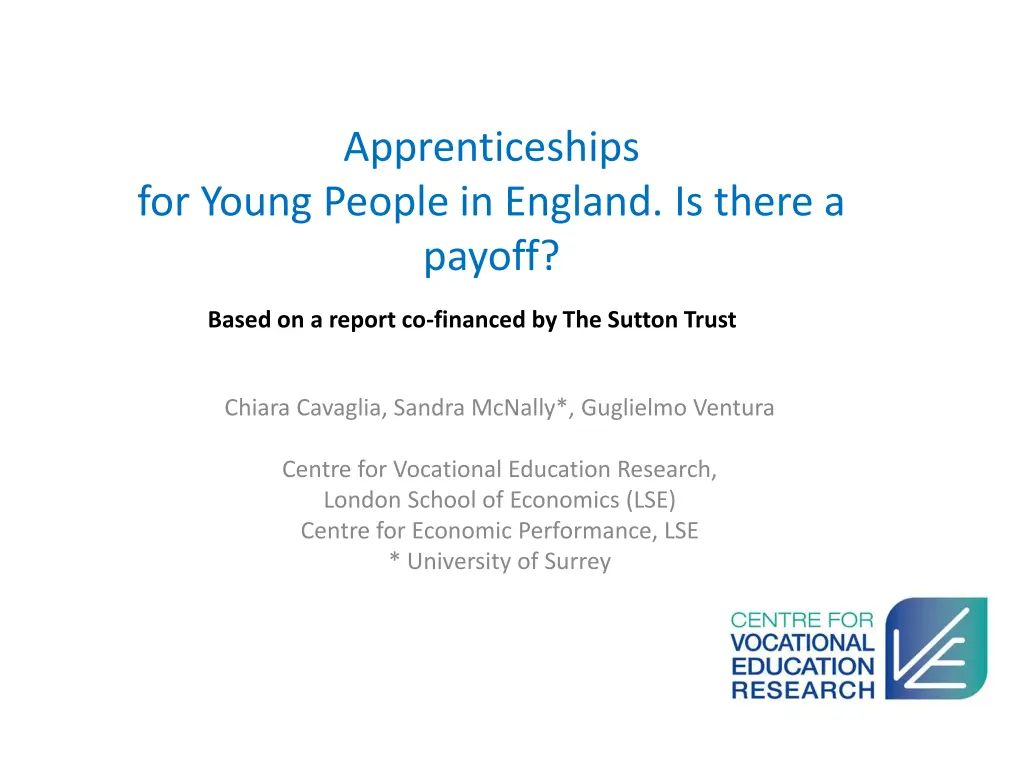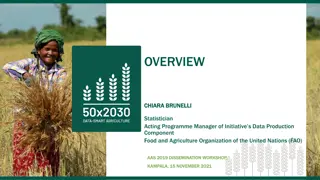
Apprenticeships for Young People in England: A Report Analysis
Explore the payoff of apprenticeships for low to medium achievers in England based on a report co-financed by The Sutton Trust. The study delves into the impact of apprenticeships over school- or college-based education, using administrative data from various sources including National Pupil Database and HMRC records. Discover the characteristics of apprentices and their potential benefits in comparison to other educational pathways.
Download Presentation

Please find below an Image/Link to download the presentation.
The content on the website is provided AS IS for your information and personal use only. It may not be sold, licensed, or shared on other websites without obtaining consent from the author. If you encounter any issues during the download, it is possible that the publisher has removed the file from their server.
You are allowed to download the files provided on this website for personal or commercial use, subject to the condition that they are used lawfully. All files are the property of their respective owners.
The content on the website is provided AS IS for your information and personal use only. It may not be sold, licensed, or shared on other websites without obtaining consent from the author.
E N D
Presentation Transcript
Apprenticeships for Young People in England. Is there a payoff? Based on a report co-financed by The Sutton Trust Chiara Cavaglia, Sandra McNally*, Guglielmo Ventura Centre for Vocational Education Research, London School of Economics (LSE) Centre for Economic Performance, LSE * University of Surrey
Motivation Apprenticeships have gained political momentum in the last decade: 2008 Labour government: one in five of all young people in an apprenticeship within the next decade 2015 Conservative manifesto: committed to 3 millions apprenticeship starts by 2020. Since April 2017 apprenticeship levy of 0.5% for large employers.
Research question 1. Is there a payoff from having an apprenticeship, over and above school- or college-based education? Focus on low to medium achievers (level 2 and level 3 vocational education) With admin data
Data Longitudinal Educational Outcomes: 1. National Pupil Database (NPD) 2. Individualised Learner Record (ILR) 3. Higher Education Statistics Agency (HESA) 4. HMRC data: administrative data on earnings, employment spells from tax records, from 2004-2015
Sample Learners who were 16 (and undertook their GCSE exams in 2002/03 AND whose highest educational qualification is a qualification at level 2 or 3 ( 50% of the overall cohort)
Groups We divide men and women into 2 groups and 3 subgroups: Level 2 - with highest education only academic level 2 (GCSE), who have never started an apprenticeship - with highest education VET level 2, who have never started an apprenticeship - with highest education academic or VET level 2, who have started an apprenticeship Level 3 - with highest education only academic level 3 (A levels), who have never started an apprenticeship - with highest education VET level 3, who have never started an apprenticeship - with highest education academic or VET level 3, who have started an apprenticeship
Who are the apprentices? When compared to the other 2 groups (academic and vocational without an apprenticeship): Those starting an apprenticeship are more likely to: - Be white - Speak English as first language And less likely to: - Come from a disadvantaged background (measured in terms of FSM eligibility), especially for men. - Come from 10% most deprived areas Finally, their prior performance at school is between those with only academic qualifications (the highest) and those with only vocational qualification (the lowest)
Earnings profiles for females and males Level 3 Male apprentices> Males with only GCSE > Males with Vocational Females with GCSE> Female apprentices>=Females with Vocational .Similar patterns at level 2
The 5 most popular sectors for advanced apprenticeships Highest associated earnings Males Males Females Females Engineering Accounting and Finance 1.4% 2.6% 3.8% Manufacturing Technologies Administration 6.9% ICT Practitioners Retail and Wholesaling 24.0% 31.9% 21.8% 22.1% Accounting and Finance Health and Social care Foundations for Learning and Life Hospitality and Catering 12.6% Travel and Tourism Building and Construction 6.9% 1.6% 22.6% 4.8% 3.1% 4.9% Lowest associated earnings Foundations for Learning and Life 2.7% Transportation Operations and Maintenance 3.8% 3.0% 2.9% 2.3% Notes: Ordered from the lowest to the highest associated earnings. Computed on advances apprenticeship for the 2003 cohort Source: English administrative data The most popular sector for men, Engineering, is also the highest paying The most popular sector for women, Child Development and Well Being, is the lowest paying
Econometric analysis But the previous statistics are just raw averages Next, we present the payoffs, after taking into account that learners/workers are different (in terms of ethnicity, background, of ability, etc )
Earnings payoffs (age 28) Level 2 Level 3 Males Females Males Females (1) (2) (3) (4) (5) (6) (7) (8) Vocational -0.006 0.074*** 0.042** 0.107*** -0.018 0.023* -0.075*** -0.046*** With apprenticeship 0.112*** 0.229*** 0.038** 0.145*** 0.242*** 0.368*** -0.023 0.092*** 19,709 13,621 22,464 18,500 Average earnings academic Additional Controls: Years of experience * p<0.05, ** p< 0.01, *** p< 0.001 Notes: Yearly gross earnings in 2015 prices. Excluded top and bottom 1% of yearly earnings distribution. Regressions include the following controls: demographic characteristics (White British, English as first language, FSM eligibility, IDACI score), prior attainment in Key Stage 4, prior attainment in Key stage 2 (English and Maths) and secondary schools' fixed effects. Also apprentices earn more if they have completed their apprenticeship, and if their apprenticeship is at level 3 No difference by SES, white vs non-white, if living in London, if living in 10% most deprived areas after we control for all other characteristics.
Differences by sector Males Females Level 2 (1) Level 3 (2) Level 2 Level 3 (1) (2) 0.074*** 0.024* 0.106*** -0.052*** Vocational with no apprenticeship Vocational with no apprenticeship Apprenticeship in Engineering 0.376*** 0.550*** Apprenticeship in Childcare 0.082** -0.087*** Apprenticeship in Construction 0.224*** 0.340*** 0.189*** 0.014 Apprenticeship in Healthcare Apprenticeship in Administration 0.197*** 0.174*** 0.163*** 0.206*** Apprenticeship in Administration Apprenticeship in Transportation 0.260*** 0.373*** Apprenticeship in Service enterprises 0.022 -0.068* 0.192*** 0.268*** 0.189*** 0.142*** Apprenticeship in another sector Apprenticeship in another sector 19,709 22,464 13,621 18,500 Average earnings academic Average earnings academic * p<0.05, ** p< 0.01, *** p< 0.001 Notes: Yearly gross earnings in 2015 prices. Excluded top and bottom 1% of yearly earnings distribution. Regressions include the following controls: demographic characteristics (White British, English as first language, FSM eligibility, IDACI score), prior attainment in Key Stage 4, prior attainment in Key stage 2 (English and Maths) and secondary schools' fixed effects.
What about male apprentices at level 3 vs male graduates? If we take into account that workers are different from each other ..
Payoffs of apprentices and graduates Change in earnings with respect to: Degree in Engineering Any degree Level 3 apprenticeship in Engineering 0.266*** 0.061 Level 3 apprenticeship in Construction 0.083*** -0.150*** Level 3 apprenticeship in Administration -0.012 -0.208*** Level 3 apprenticeship in Construction 0.062*** -0.150*** Level 3 apprenticeship in another sector 0.068** -0.129*** Additional Controls: Years of experience * p<0.05, ** p< 0.01, *** p< 0.001 Notes: Yearly gross earnings in 2015 prices. Excluded top and bottom 1% of yearly earnings distribution. Regressions include the following controls: demographic characteristics (White British, English as first language, FSM eligibility, IDACI score), prior attainment in Key Stage 4, prior attainment in Key stage 2 (English and Maths) and secondary schools' fixed effects. We are comparing graduates and apprentices who have completed their qualification
Conclusions Our study suggests that: 1. there are some payoffs associated with apprenticeships, but a lot of heterogeneity: according to the sector and level of education For males and women 2. Some differences in terms of who accesses an apprenticeship by SES, but this does not affect the payoffs. More research needed Raises questions about how to expand apprenticeship systems in countries like the UK (and what to tell young people)
Thank you!!! Any comments are welcome (c.cavaglia@lse.ac.uk) The full report can be found: http://cver.lse.ac.uk/textonly/cver/pubs/cverdp010.pdf Or here: https://www.suttontrust.com/research-paper/better-apprenticeships-quality-access-social- mobility/ And very soon a related paper where we try to deal with selection in order to obtain causal estimates Check our website for this and other interesting work on skills and education! http://cver.lse.ac.uk/
Types of apprenticeships Year of GCSE exam Level 2 Level 3 Level 4 Level 5 2002 2003 2004 2005 2006 2007 2008 13.43% 13.50% 14.18% 15.21% 15.97% 17.35% 18.43% 6.07% 6.20% 6.41% 6.62% 7.06% 7.76% 8.49% 0.00% 0.00% 0.01% 0.05% 0.11% 0.14% 0.18% 0.00% 0.00% 0.00% 0.00% 0.00% 0.00% 0.00% Source: English administrative data (2003-2015)




